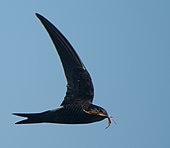ഹിമാലയൻ ശരപ്പക്ഷി
| ഹിമാലയൻ ശരപ്പക്ഷി | |
|---|---|

| |
| Scientific classification | |
| കിങ്ഡം: | |
| Phylum: | |
| Class: | |
| Order: | |
| Family: | |
| Genus: | |
| Species: | A. pacificus
|
| Binomial name | |
| Apus pacificus (Latham, 1801)
| |

| |
Breeding visitor (ranges are approximate)
Breeding range of three former subspecies Non-breeding | |
ആംഗലത്തിൽ Pacific swift എന്ന പേരും ശാസ്ത്രീയ പേര് Apus pacificus എന്നുമുള്ള ഹിമാലയൻ ശരപ്പക്ഷി[2] [3][4][5] ഒരു ദേശാടനപ്പക്ഷിയാണ്. Apus pacificus leuconyx അഥവാ Apus leuconyx (ഇംഗ്ലീഷ്: Blyth's swift) ആണ് ദക്ഷിണേഷ്യയിൽ കാണപ്പെടുന്നത്.[6]
പ്രജനനം
[തിരുത്തുക]ഗുഹകളിലും കെട്ടിടങ്ങളുടെ മേൽക്കൂരയിലും കൂട് ഉണ്ടാക്കുന്നു. പകുതിയുള്ള കപ്പിന്റെ ആകൃതിയിലുള്ള ഇവയുടെ കൂട്, തിരശ്ചീന തലത്തിൽ ഉണങ്ങിയ പുല്ലും മൃദുവായ വസ്തുക്കളും ചേർത്തു് ഉമിനീരുകൂട്ടി ഉറപ്പിക്കുന്നു.2-3 വെള്ള മുട്ടകളാണ് ഇടുന്നത്. .[7] 17 ദിവസംകൊണ്ട് വിരിയുന്നു.കുറെ ദിവസംകൊണ്ട് മാത്രമെ കുഞ്ഞുങ്ങൾ പറക്കാനാവുന്നുള്ളു.വിരിയുമ്പോൾ തൂവലുകൾ ഉണ്ടാവില്ല. കണ്ണുകൾ തുറക്കില്ല. മോശം കാലാവസ്ഥയിൽ രക്ഷിതാക്കൾക്ക് കുഞ്ഞുങ്ങൾക്ക് തീറ്റ കൊടുക്കാനാവാതാവുമ്പോൾ അവ ശരീരത്തിലെ കൊഴുപ്പുകൊണ്ട് ജീവൻ നിലനിർത്തും.പൂവനും പിടയും ചേർന്നാണ് അടയിരിക്കുന്നതുംകുഞ്ഞുങ്ങളെ തീറ്റുന്നതും.
തിറ്റ
[തിരുത്തുക]മറ്റു ശരപക്ഷികളെപ്പോലെ പറക്കുന്നതിനിടയിൽ പിടിക്കുന്ന പ്രാണികളാണ് ഇവയുടെ ഭക്ഷണം.[8] ഇവ മറ്റുള്ളവയെ അപേക്ഷിച്ച് കൂടുതൽ ഉയരത്തിലാണ് ഇര തേടുന്നത്. ഇവ വൈവിദ്ധ്യമുള്ള തീറ്റകഴിക്കുന്നതായി രേഖപ്പെടുത്തിയിട്ടുണ്ട്. ചൈനയിൽ നടത്തിയ പഠനത്തിൽ ഇവ കൃഷി , വനം എന്നിവയുടെ സ്ത്രു കീടങ്ങളെ ഭക്ഷിക്കുന്നതായി കണ്ടിട്ടുണ്ട്. [9] ഈ പക്ഷിയെHirundo pacifica'’ എന്നാണ് ആദ്യമായി 1801ൽ ജോൺ ലതാം എന്ന പക്ഷി ശാസ്ത്രഞജ്ഞൻ ആദ്യമായി രേഖപ്പെടുത്തിയത്.[10]
രൂപവിവരണം
[തിരുത്തുക]
17-18 സെ.മീ. നീളം, 43-54 സെ.മീ ചിറകു വിരിപ്പ്,.[11] പിടകൾക്ക് അല്പം വലിപ്പം കൂടും [8] ഇതിന്റെ ഫോർക്ക് പോളുള്ള വാൽ കൂടുതൽ കുഴിഞ്ഞതാണ്. ചാര നിറമുള്ള തലയാണ്. ചിറകിന്റെ അടിവശത്തിന് ചാര നിറം. മുഴുവൻ കറുപ്പായ ഈ പക്ഷിയുടെ മുതുക് വെളുപ്പാണ്. അടിവശത്ത് കടുത്ത വരകളുണ്ട്. ദ്വിലിംഗങ്ങളും കാഴ്ചയ്ക്ക് ഒരേപോലെയാണ്. കണ്ണിനു തവിട്ടു നിറം, ചെറിയ കൊക്ക്, ചെറി കാലുകൾ.[11] ചാര നിറത്തിലുള്ള കഴുത്തും അതിലും ഇരുണ്ട അടിവശവും ഉണ്ട്.
വിതരണം
[തിരുത്തുക]പൂർവഏഷ്യയിൽ പ്രജനനം നടത്തുന്നു. തണുപ്പുകാലത്ത് തെക്കു കിഴക്കെ ഏഷ്യ, ആസ്ത്രേലിയ എന്നിവിടങ്ങളിലേക്ക് ദേശാടനം നടത്തുന്നു. ദക്ഷിണ ഇന്തോനേഷ്യ, മെലാനേഷ്യ, ആസ്ത്രേലിയ, ടാൻസ്മാനിയ, സുമാത്ര, ജാവ എന്നിവിടങ്ങളിലേക്കും ഡേശാടനം നടത്താറുണ്ട്.[12] ഇവയെ ന്യുസിലാന്റ്, ബ്രുണൈ, മാലി ദ്വീപ്, സീഷെൽസ് എന്നിവിടങ്ങളിലും രേഖപ്പെടുത്തിയിട്ടുണ്ട്.

അവലംബം
[തിരുത്തുക]- ↑ "Apus pacificus". IUCN Red List of Threatened Species. Version 2013.2. International Union for Conservation of Nature. 2012. Retrieved 26 November 2013.
{{cite web}}: Cite has empty unknown parameter:|last-author-amp=(help); Invalid|ref=harv(help); Unknown parameter|authors=ignored (help) - ↑ J, Praveen (17 November 2015). "A checklist of birds of Kerala, India". Journal of Threatened Taxa. 7 (13): 7983–8009. doi:10.11609/JoTT.2001.7.13.7983-8009.
- ↑ "eBird India- Kerala". eBird.org. Cornell Lab of Ornithology. Retrieved 24 സെപ്റ്റംബർ 2017.
- ↑ കെ.കെ., നീലകണ്ഠൻ (2017). കേരളത്തിലെ പക്ഷികൾ (5 ed.). കേരള സാഹിത്യ അക്കാദമി. p. 486. ISBN 978-81-7690-251-9.
{{cite book}}:|access-date=requires|url=(help) - ↑ Grimmett, Richard; Inskipp, Tim; P.O., Nameer (2007). Birds of Southern India [Thekke Indiayile Pakshikal (Malayalam version)]. Mumbai: BNHS.
{{cite book}}:|access-date=requires|url=(help) - ↑ Leader, P J. (2011). "Taxonomy of the Pacific Swift Apus pacificus Latham, 1802, complex". Bulletin of the British Ornithologists' Club. 131: 81–93.
- ↑ Lack, David (1956). "A review of the genera and nesting habits of swifts". The Auk. 73 (1): 1–32. JSTOR 4081635.
- ↑ 8.0 8.1 Chantler (1999) p. 455.
- ↑ Cheng, Zhaoqin; Zhou, Benxiang (1987). "Diet analyses of the large white-rumped swift, Apus pacificus, at Chenlushan Island in the Yellow Sea and examination of their pattern of activities by radar". Acta Zoologica Sinica. 33: 180–186.
- ↑ Latham (1801) p. lviii.
- ↑ 11.0 11.1 Brazil (2009) p. 272.
- ↑ "Updates & Corrections - August 2011". The Clements Checklist. Cornell Laboratory of Ornithology. Retrieved 26 June 2013.
{{cite web}}: CS1 maint: url-status (link)
- Brazil, Mark (2009). Birds of East Asia. London: A & C Black. ISBN 0-7136-7040-1.
- Chantler, Phillip (1999). "Family Apodidae (Swifts)". In del Hoyo, Josep; Elliott, Andrew; Sargatal, Jordi (eds.). Handbook of the Birds of the World, Volume 5: Barn-owls to Hummingbirds. Barcelona, Spain: Lynx Edicions. ISBN 84-87334-25-3.
- Chantler, Phillip; Driessens, Gerard (2000). Swifts: A Guide to the Swifts and Treeswifts of the World. London: Pica Press. ISBN 1-873403-83-6.
- van Duivendijk, Nils (2011). Advanced Bird ID Handbook: The Western Palearctic. London: New Holland. ISBN 1-78009-022-6.
- Jobling, James A (2010). The Helm Dictionary of Scientific Bird Names. London: Christopher Helm. ISBN 978-1-4081-2501-4.
- Kaufman, Kenn (2001). Lives of North American Birds. Oxford: Houghton Mifflin Harcourt. ISBN 0-618-15988-6.
- Latham, John (1801). Supplementum indicis ornithologici sive systematis ornithologiae (in Latin). Londoni: Leigh et Sotheby.
{{cite book}}: CS1 maint: unrecognized language (link) - Peterson, Paul; Atyeo, Warren T; Moss, W Wayne (2007). Feather Mite Family Eustathiidae (Acarina: Sarcoptiformes): Monographs of The Academy of Natural Sciences of Philadelphia, No. 21. Philadelphia: Academy of Natural Sciences. ISBN 1-4223-1927-X.
- Scopoli, Giovanni Antonio (1777). Introductio ad Historianum naturalem (in Latin). Prague: Wolfgangum Gerle.
{{cite book}}: CS1 maint: unrecognized language (link) - Simpson, Ken; Day, Nicolas (2010). A Field Guide to the Birds of Australia, 8th Edition. London: Penguin. ISBN 978-0-670-07231-6.

